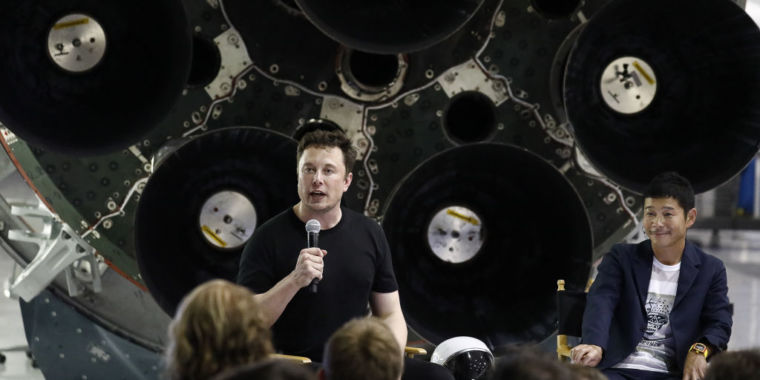Here’s why a Japanese billionaire just canceled his lunar flight on Starship
No Moon —
“I feel terrible making the crew members wait longer.”

Enlarge / Elon Musk speaks as Yusaku Maezawa, founder and president of Start Today Co., looks on at an event at the SpaceX headquarters in Hawthorne, California, in 2018.
Patrick T. Fallon/Bloomberg via Getty Images
On Friday night the dearMoon project—a plan to launch a Japanese billionaire and 10 other ‘crew members’ on a circumlunar flight aboard SpaceX’s Starship vehicle—was abruptly canceled.
“It is unfortunate to be announcing that ‘dearMoon’, the first private circumlunar flight project, will be cancelled,” the mission’s official account on the social media site X said. “We thank everyone who has supported us and apologize to those who have looked forward to this project.”
Shortly afterward the financial backer of the project and its ‘crew leader,’ Yusaku Maezawa, explained this decision on X. When Maezawa agreed to the mission in 2018, he said, the assumption was that the dearMoon mission would launch by the end of 2023.
“It’s a developmental project so it is what it is, but it is still uncertain as to when Starship can launch,” he wrote. “I can’t plan my future in this situation, and I feel terrible making the crew members wait longer, hence the difficult decision to cancel at this point in time. I apologize to those who were excited for this project to happen.”
The mission was to be Starship’s first human spaceflight to launch from Earth, fly around the Moon, and come back. Now, it’s not happening. Why did this happen, and what does it mean?
Origins of the mission
Maezawa and Musk made the announcement, side by side, at SpaceX’s rocket factory in Hawthorne in September 2018. It was something of an odd but important moment. It seemed significant that SpaceX was signing its first commercial contract for the massive Starship rocket. And while the value was not disclosed, Maezawa was injecting something on the order of the low hundreds of millions of dollars into the program.
Maezawa, however, always came off as a bit non-serious. He said he would hold a competition to fill 10 other seats on board the vehicle. “I did not want to have such a fantastic experience by myself,” he said. “I would be a little lonely.” Later, he did select a crew of creative people.
Initially, however, Maezawa did take the project seriously. When I watched the very first Starship hop test in July 2019, there were only a handful of visitors on hand to view the brief flight of “Starhopper.” One of them was a representative of Maezawa who was keeping close tabs on the progress of Starship.
As big space projects do—and to the surprise of no one—Starship ran behind in its development. The first test flight did not occur until April 2023, and that was just the beginning. The dearMoon mission lay at the very end of a long line of tests that the vehicle must complete: safe launch, controlled flight in space, safe landing of the Starship upper stage, in-space refueling, habitability in space, and much more.
With the fourth test flight of Starship coming in a few days, as early as June 5, SpaceX has so far demonstrated the ability to safely launch Starship. So it remains at the beginning of a challenging technical journey.
A turning point
One of the biggest impacts to the dearMoon project came in April 2021, when NASA selected the Starship vehicle as the lunar lander for its Artemis Program. This put the large vehicle on the critical path for NASA’s ambitious program to land humans on the surface of the Moon. It also offered an order of magnitude more funding, $2.9 billion, and the promise of more if SpaceX could deliver a vehicle to take humans down to the Moon’s surface from lunar orbit, and back.
Since then SpaceX has had two clear priorities for its Starship program. The first of these is to become operational, and begin deploying larger Starlink satellites. And the second is to use these flights to test technologies needed for NASA’s Artemis Program, such as in-space propellant storage and refueling.
As a result other aspects of the program, including dearMoon, were deprioritized. In recent months it became clear that if Maezawa’s mission happened, it would not occur until at least the early 2030s—at least a decade after the original plan.
Changing fortunes
In the meantime, Maezawa’s priorities also likely changed. According to Forbes, when the plan was announced in 2018, the entrepreneur had a net worth of about $3 billion. Today he is estimated to be worth only half of that. Additionally, he scratched his itch to go to space in 2021, flying aboard a Russian Soyuz vehicle for a 12-day trip to the International Space Station.
The writing has been on the wall for a while about Maezawa, since SpaceX founder Elon Musk unfollowed the Japanese entrepreneur on X earlier this year. (This is a sure sign of his disfavor. Musk has unfollowed me twice on Twitter/X after stories or interactions he did not like.) It is probable that the combination of developmental delays and Maezawa’s personal fortunes led the parties to disband the project.
This all leaves a clearer road ahead for Starship: Become operational, start flying Starlink satellites, and begin ticking off the technical challenges for Artemis. Then, several years from now, the company will turn its attention toward the challenging prospect of launching humans inside Starship from Earth, and then landing back on the planet. The first of these people will be another billionaire, Jared Isaacman, who has already flown on Crew Dragon and plans at least two more such flights before the pioneering Starship mission.
Here’s why a Japanese billionaire just canceled his lunar flight on Starship Read More »
